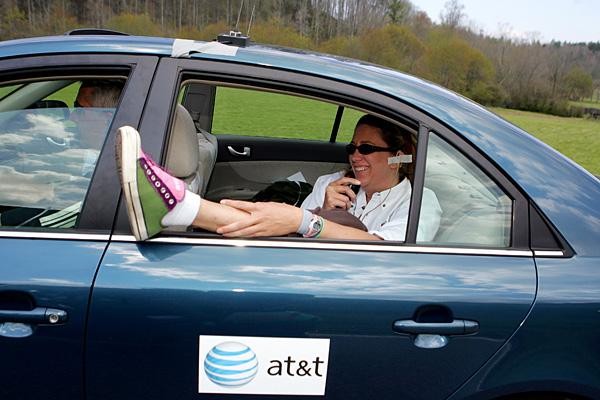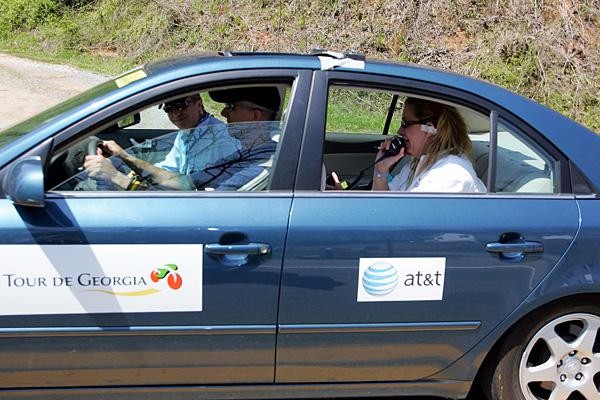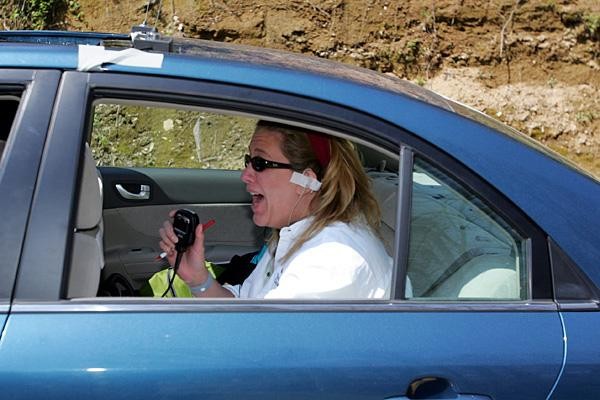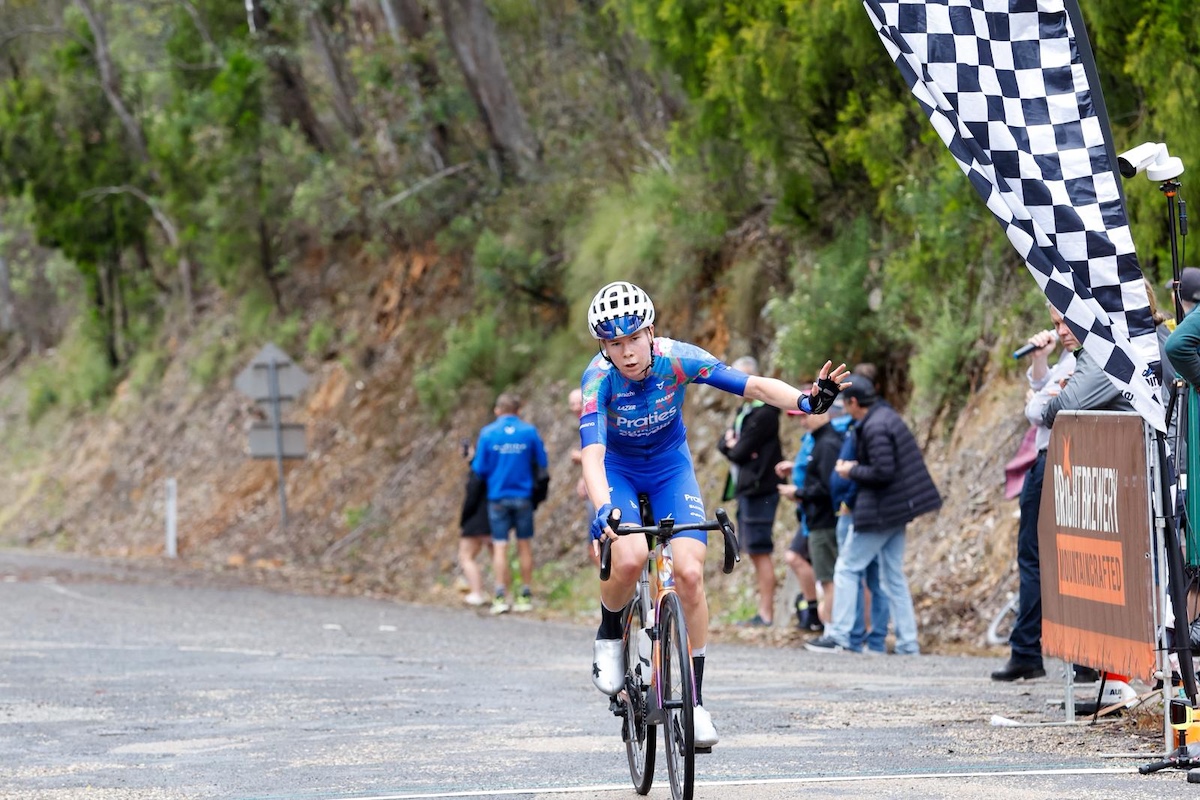The voice of American cycling
The numer of vehicles on the road in what is known as the 'race caravan' rivals that of a small...




Tales from the peloton, June 14, 2007
Anyone who has seen a professional cycling race first hand, or even on TV, knows that there is much more going on than a few hundred cyclists racing on the road. The amount of coordination it takes to close a series of roads is daunting anywhere, and nearly impossible in the United States of America learns Cyclingnews Mark Zalewski.
The numer of vehicles on the road in what is known as the 'race caravan' rivals that of a small army. The key to both safety and coordination is communication - and the person chiefly responsible for relaying all of the information to the people who need it is called Radio Tour. In the biggest races on this side of the pond, from the days of Tour DuPont to this year's Tour de Georgia, that unique duty is usually performed by Lorinn Rhodes.
For those that love to be 'in the know' when it comes to cycling racing, the job of Radio Tour is likely the best bet to accomplish this. The Radio Tour person gets to be right in the middle of all the action, riding in the car with the chief commissarie that sits directly behind the peloton. But this job is not for the lighthearted. All of the general information that goes on during a stage or race flows through this person to be broadcast to all of the team and race vehicles - riders crashing, mechanical, feeding calls, road condition alerts - you name it and the Radio Tour likely has had to broadcast it during a race.
But how does one get this job? Well, first it helps to know a European language along with English - namely French, since it is one of the official languages of the Olympics and of most sports. That is how Lorinn Rhodes got her first start as Radio Tour. "I first did Radio Tour at Tour de Trump in 1992," she explained. "I had been hired to do results and I got off the airplane and they said, 'You speak French, right? We've just been told by the UCI that we have to have Radio Tour in French so we're going to have you sit in the back seat of the officials car and tell everyone what is going on."
With little introduction on what exactly she was in for, Rhodes found herself in the back seat of a car for six hours working in a baptism by fire. "I had worked at the last three Coors Classics in operations as an interpreter and housing coordinator, and marshaled at Tour de Trump - so I new the scene but very little about front or rear wheels, flats and racing," she said.
"I had no idea what Radio Tour was, but I knew what peloton meant and a few other words. That first stage was a lot to learn. The first thing they told me is that when a rider has a mechanical he will drift back towards our car. We'll try to figure out what that is and call his team car up. So I would say, 'So and so has a...' no he doesn't, he is peeing. They neglected to say that they will drift back to pee as well!"
The latest race content, interviews, features, reviews and expert buying guides, direct to your inbox!
The key for Rhodes was her fluency in French - something she never thought would ever be useful beyond her high school foreign exchange programme. "I studied French in high school and studied abroad in Belgium," explained Rhodes. "The first bike race I ever saw was Liège - Bastogne - Liège. I was living in a house and they said there was a bike race. We went outside and I had no idea. On there return back into Liège there was a solo breakaway by Moreno Algente. He was drinking from a bottle and I said, 'Allez monsier, allez!' thinking he would give me a souvenir. Not knowing that they throw water bottles out all the time he threw the bottle right at my feet. It was this junky, trashed water bottle but I was the most popular kid at school the next day because he won the race!"
"Little did I know that you could check the box and that French could be a career other than teaching," added Rhodes. "French is the international language of cycling, soccer and the Olympics so that has kept me going. When I was living in Switzerland I worked on the World Cup in France, so again I spoke French every day for work."
When the Tour de Georgia began, Rhodes got the call-up based upon her earlier years of doing Radio Tour. "The first year the race came to Georgia, I was living in Colorado again and the race promoter knew I spoke French," she explained. "And I had family connections in Georgia so they asked me to come and everybody loved having a female voice. People said that because there are mostly men in the cars a female voice would cut through better. And that year I did Philly too. That was my first year really getting back."
How does it work?
Have you ever tried to listen to two conversations at the same time? Take that and add a third stream of conversation and that is your minimum information input and output as Radio Tour. "I listen to at least two channels - the caravan channel with 'red alerts', things to watch out for in the road - and then the officials channel in another ear. And sometimes there might be an information bike or a broadcast channel. I give the 'play-by-play' of what goes on in the race, and the necessary information like calling team cars forward when a rider is in distress - mechanicals, feeding - which can get pretty chaotic. Lots of juggling people's needs, both on the radio and in the car. And we are constantly swapping positions with the other cars for services."
A race like the Tour of California or Tour de Georgia has a dedicated radio system with fifteen channels for various uses, including: officials, press, caravan, medical and of course Radio Tour. But everything centres around the chief commisaire's car. "There are the three of us in that car: the driver, the chief comm and me -- and we are all looking for hands up, for calls, and seeing if it is a rear or front wheel. By now most teams have radio communications and seven times out of ten the car already knows what is going on. But if a crash happens, obviously the rider doesn't have time to say, 'I fell down!' So it's important to say which riders are down and on the ground."
"The officials are the ones I rely on for most of my information, like time checks," she added. "In Europe they have separate people providing information so the officials don't have to worry about supplying information and can just do their job. But it goes both ways because sometimes I am an extra set of eyes that can see things that the commissaires cannot see."
Highlights and lowlights
Of course, being in the centre of all the action has left Rhodes with some interesting stories, many of them humorous. "The second year [of Tour de Trump] we had a convertible and all the riders would come up and talk," reflected Rhodes. "One year Davis [Phinney] came up and borrowed my sunscreen and passed it throughout the peloton. He brought back an empty bottle and said, 'I owe you a tube of sunscreen.' Michele Zanoli became a father during one of the stages, and he borrowed a cell phone so he could talk to his wife - right there at the back of the race. The convertible made it a big social scene, but it was one year and out."
"There is always something funny," she continued. "At one of the starts in Georgia there was a high school kid selling Krispy Kreme donuts. So we bought a box and passed out some to the motos. When you are going six hours in the car and you can't even stop to pee, you have to come up with something. We are so jealous, there are people peeing around me all day and we can't! We've seen a couple of mooners or women flashing their chest, especially in California."
California seems to have more shenanigans than the other races in the States. "In California one stage a rider's seat came off. There was a seatpost with a seat on the ground when we went by. Then moments later we saw a rider with his hand up because he couldn't sit down! We saw the evidence of what was eventually coming."
The Radio Tour really does see everything that happens in a race. "In California [Paolo] Bettini never left the last wheel!" remembered Rhodes. "He was in the back the majority of the race, pedaling with no hands, talking and telling stories... nearly every stage. He was often chatting with a Quick Step guy and one day they had a bet... they would say, '1-2-3, go!' and would sprint to the front of the field and then would float back and laugh. It was wild to see the world champion at the back, not because he was out of shape but because he was just having a good time - waving to people who knew his name.
"You can really tell the teams that are less organized - multiple riders coming back for bottles instead of just one, or when the team car just left and they call it up again," she said. "Even the recovery from a mechanical, bringing their guy back. So many people don't understand the teamwork that is involved, and we are in a perfect spot to see that teamwork displayed."
And then there are the not so nice moments. "This year the peloton hit a puppy in Georgia! We weren't sure who hit the puppy - but they started to separate and when we got to it there was a little puppy barking in the middle of the road! But he couldn't move his back legs so he was dragging himself to get out of the way. The next couple of cars slowed down and then eventually Navigators came on it and stopped the entire caravan and let the puppy limp off. He eventually got up and walked off."
Many people involved with racing in America remember the fourth stage of the 2005 Tour de Georgia, with a sudden thunderstorm hitting the race on the first big descent of the race. Rhodes also listed this as one of the scarier moments as Radio Tour, but said that this illustrated one of the other key jobs in a race, the drivers. "We couldn't see five feet in front of us, but we had a really good driver," said Rhodes. "The drivers have to be working all of their senses - knowing where all the riders are and keeping track of who is where. That was a scary decent. We all thought that if a rider went down it would be very hard for us to stop."
Many times, the fun comes hand-in-hand with the scary. "Manyunk is fun on the climb and the descent is the scariest thing, because of the drunk spectators running across the road! There is no fencing there because it would cost a fortune." Philly week also produced the top of the scary moment list for Rhodes.
"Scariest moment ever was in Trenton with a crash on the last lap in 2003. We were going back into the park for the last time - from the four lane road into a right-hand turn under the train trestle. As they were shuffling back in after the turn, Scott Zwizanski hopped the curb and went cheek first into the train trestle and then fell down right in front of us. We saw the speed at which he hit the trestle, cement barrier, and then hit the ground equally as hard and didn't move. We had to stop but yet the race is still moving off ahead into the park. We had to go around. Usually the medical car is the first car right after us and I look around to them as I say, 'medical.' I turned around this time and they were sill coming back from a scuffle at the other end of the course. So I said, 'Medical, medical medical!' And the doctor then knew in my voice that it was bad."
"John from Mavic stopped in front of him and blocked all of the team cars from going around him. So we went around the park alone and the three of us in the car couldn't talk - we were speechless and there were no vehicles behind us. We went all the way around and as we came back out I heard the technical director say, 'Do you still need ambulance?' And I said yes, it is still not there. All the team cars turned around and caught back on with us at that point as the ambulance worked its way up. Thee good news is the rider ended up fine and was racing a year later."
The crashes are an exercise in extreme delegating for the chief commisaire's car, when the natural reaction to a bad crash is to make sure everyone is okay. "Even like the crash in Santa Rosa this year, our job is not to assess the crash - our job is to stick with the race and let people know what is going on, and still be ready in case there is another crash up the road," said Rhodes.
But those bad times are overshadowed by those special moments in a race, the deciding moment where a race or tour is won and lost. "The best is on the climbs when we have a commisaire that gets us into position. We are supposed to be with the GC riders - like on Brasstown we were with Brajkovic and Vande Velde. But one of the most memorable for me was twice, Armstrong on Brasstown Bald, side-by-side with Landis one year, and Voight another year. We were right behind them, seeing who is on the left and who is on the right. I could see them and didn't have to rely on somebody giving me information. One time the TV camera went out and they had to rely solely on me to provide information on what was happening. There were huge crowds, potentially scary, but ultimately a lot of fun."
The Radio Tour is arguably one of the most interesting jobs in a bike race, but also one of the toughest and most rewarding. "There are some great times we come through sprint towns with huge crowds, or finishing circuits when the pace is high and adrenaline just takes over for everybody."
And if you are thinking that it might be a fun job, Rhodes has some advice: "For all you kids reading this, 'Study your French!"

